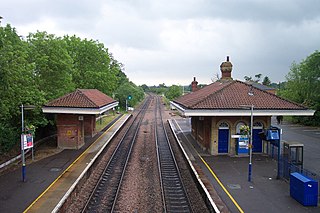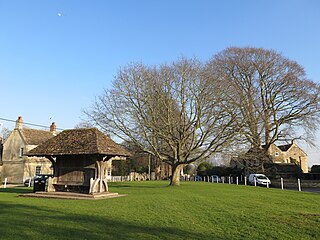
Yeovil Junction railway station is the busier, but less central, of two railway stations serving the town of Yeovil in England. The station is 2 miles (3.2 km) outside the town, in the village of Stoford. Although Yeovil is in Somerset, the station was in Dorset until 1991. It is 122 miles 48 chains (197.3 km) down the line from London Waterloo.

The Wessex Main Line is the railway line from Bristol Temple Meads to Southampton Central. Diverging from this route is the Heart of Wessex Line from Westbury to Weymouth. The Wessex Main Line intersects the Reading to Taunton Line at Westbury and the West of England Main Line at Salisbury.

Salisbury railway station serves the cathedral city of Salisbury in Wiltshire, England. It is 83 miles 43 chains (134.4 km) from London Waterloo on the West of England line to Exeter St Davids. This is crossed by the Wessex Main Line from Bristol Temple Meads to Southampton Central. The station is operated and served by South Western Railway (SWR), and is also served by Great Western Railway (GWR).

Westbury railway station serves the market town of Westbury in Wiltshire, England. The station is managed by Great Western Railway.

Chippenham railway station is on the Great Western Main Line (GWML) in South West England, serving the town of Chippenham, Wiltshire. It is 93 miles 76 chains down the line from the zero point at London Paddington and is situated between Swindon and Bath Spa on the GWML. The Wessex Main Line diverges from the GWML to the southwest of Chippenham and runs to Trowbridge via Melksham.

Melksham railway station serves the town of Melksham in Wiltshire, England. It is 100 miles 13 chains measured from London Paddington, on the TransWilts Line between Chippenham and Trowbridge that was originally part of the Wilts, Somerset and Weymouth Railway, absorbed in 1850 by the Great Western Railway.
The Wilts, Somerset and Weymouth Railway (WS&WR) was an early railway company in south-western England. It obtained Parliamentary powers in 1845 to build a railway from near Chippenham in Wiltshire, southward to Salisbury and Weymouth in Dorset. It opened the first part of the network but found it impossible to raise further money and sold its line to the Great Western Railway (GWR) in 1850.
The Devizes branch line was a railway line from Holt Junction to Patney and Chirton, in Wiltshire, England. It was named after Devizes, the largest town on the line. The branch was opened by the Great Western Railway in 1857, and from 1862 when the Reading-Hungerford line reached Devizes it became part of the shortest route from London to the West Country. Those services were re-routed in 1900, and the line closed in 1966.

The Berks and Hants Railway comprised two railway lines built simultaneously by the Great Western Railway (GWR) south and west from Reading in an attempt to keep the London and South Western Railway (LSWR) out of the area that it considered to be its territory in England.
The Langport and Castle Cary Railway is a railway line from Castle Cary railway station to Cogload Junction near Taunton, Somerset, England, which reduced the length of the journey from London to Penzance by 20+1⁄4 miles (32.6 km).

Marlborough railway stations refers to the two railway stations which served Marlborough, Wiltshire, England, until 1964.
The Salisbury branch line of the Great Western Railway from Westbury to Salisbury in Wiltshire, England, was completed in 1856. Most of the smaller stations were closed in 1955 but the line remains in use as part of the Wessex Main Line.

Wootton Bassett Junction railway station, formerly Wootton Bassett railway station, was a junction station in Wootton Bassett where the Great Western and South Wales Main Lines diverge. Opened in 1841, it closed in 1965.

Holt is a village and civil parish in the west of Wiltshire, England, about 2.5 miles (4 km) north-east of Bradford-on-Avon and 3 miles (5 km) south-west of Melksham.
The Malmesbury branch was a six-and-a-half-mile-long single track branch railway line in Wiltshire, England; it ran from Dauntsey station on the Great Western Main Line to Malmesbury. Promoted locally, it opened with considerable assistance from the Great Western Railway in 1877, and used the standard gauge. There was one intermediate station, Somerford.
The Stert and Westbury Railway was opened by the Great Western Railway Company in 1900 in Wiltshire, England. It shortened the distance between London Paddington station and Weymouth, and since 1906 has also formed part of the Reading to Taunton line for a shorter journey from London to Penzance.

Devizes railway station was the railway station serving Devizes in Wiltshire, England between 1857 and 1966. The station was on the Devizes branch line, between Pans Lane Halt and Bromham & Rowde.

The Reading–Taunton line is a major branch of the Great Western Main Line from which it diverges at Reading railway station. It runs to Cogload Junction where it joins the Bristol to Exeter and Penzance line.

Bathampton railway station is a former railway station in Bath, England, serving the community of Bathampton. The station opened on 2 February 1857 and closed on 3 October 1966. Very little remains, as the station site was replaced with improved trackwork for a nearby junction. The only significant remains are the gateposts at the head of the approach road.
Lacock Halt was a minor railway station on the Chippenham–Trowbridge section of the former Wilts, Somerset and Weymouth Railway (WSWR), which opened as far as Westbury on 2 September 1848. This connected to the Great Western Main Line at Thingley Junction and was incorporated into the Great Western Railway in March 1850 after the WSWR ran into financial difficulties.














